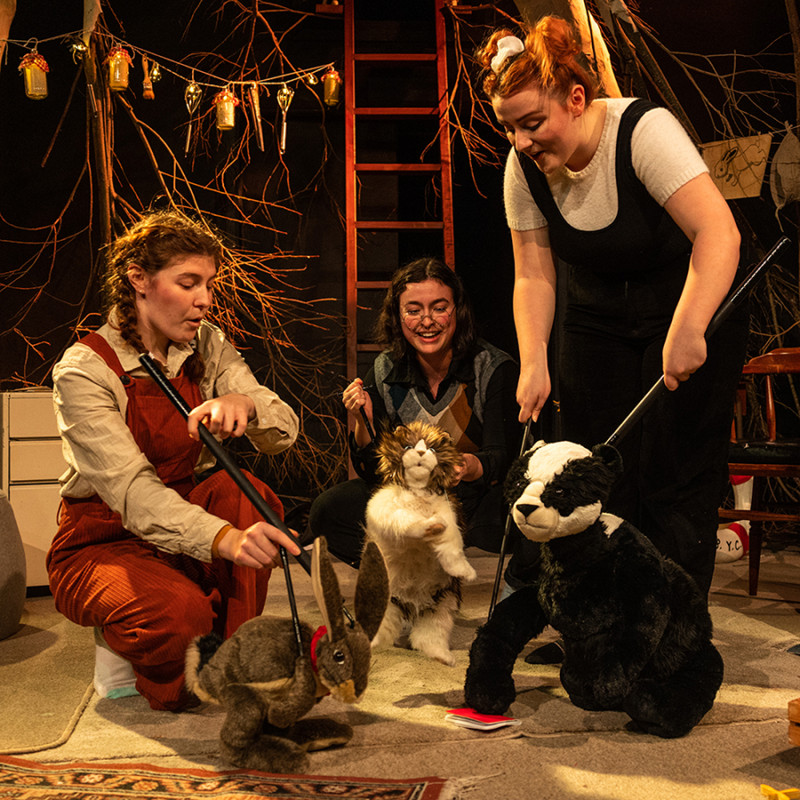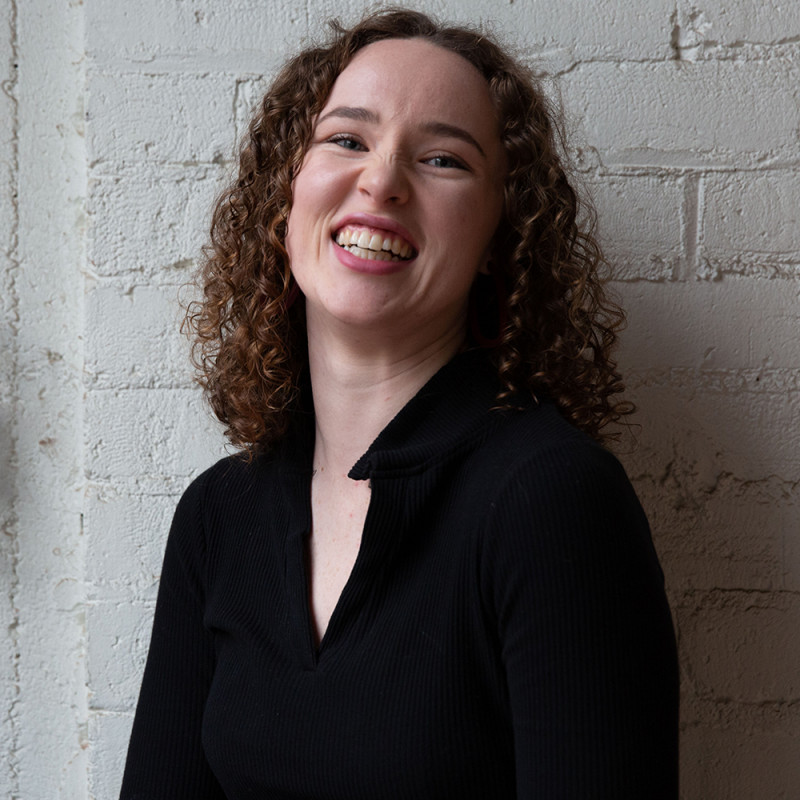
Photo by Kawkawkins Photography

Georgia Kellett
Emerging theatre companies of Wellington – Knot Theatre by Finlay Langelaan
Wellington is a melting pot of creatives. In our new emerging theatre companies of Wellington series, we explore what makes these passionate groups tick, and why they deserve your support. This time, I spoke to Georgia and Dannii Kellett of Knot Theatre, who are the creative director and designer, respectively.
How did Knot Theatre first form?
G: So back in 2017, myself and Anna Secker, who’s a current theatre student at Victoria University going into her master’s, were in high school, and we just created a show together on a whim. She was into theatre, I came up from the dance world, so we had that artistic connection. She goes ‘Have you ever thought about writing a show?’ And I went ‘No, it’s never crossed my mind,’ and she replies ‘Cool, because I want to write a comedy show about nuns.’ So, we did. We created this show called Missing Time; it was a complete whirlwind.
Knot Theatre has been together ever since? That’s seriously impressive for such a young company to last so long.
G: I finished college and went straight into training at Te Auaha, while Anna finished high school and took a gap year. We were still creating things but in different capacities, and as we’ve grown as adults, we’ve realised that we will continue to grow and work together, but for the moment I’ve sort of taken the mantle of Knot Theatre. I’m essentially the creative director in partnership with Anna.
What is Knot Theatre’s mission?
G: As it is now, it’s a company of creating stories that have some kind of plot twist or something to them that simply excites, brings joy, or creates a larger experience for audiences, in a way that isn’t restricted by the style or form of theatre. We do a lot of styles – physical theatre, puppetry, clowning, scripted work and unscripted – but they all sort of have this baseline quality of trying to bring audiences into a new world or a slightly altered one. I guess our mission is to provide enjoyment or escape to our audiences.
D: [As the set and graphic designer] my personal mission is to really push the boundaries of what theatre is. So instead of creating your traditional set, I’m keen to use different techniques, different materials, moving parts, things that light up, things that trick your eye. The past productions we’ve done have always tried to make it a bit topsy-turvy. That phrase keeps coming forward every single time we come up with a new show concept. Like the audience is coming in and we don’t want them to be completely sure what’s going on.
So, you’re more interested in a passionate response, rather than trying to find deeper meaning in a piece?
G: Yeah, it’s invoking that emotional or physical response, whether that’s laughing or crying or whatever. It’s about taking people out of their heads a little bit, and just being absorbed into whatever they’re experiencing.
What have you achieved with Knot Theatre that you’re most proud of?
D: The sets that I love the most are the ones that are a little bit out of the ordinary. The one that I think has the most background meaning was Bruises, which was on during Fringe 2021. That was a production based on male victims of domestic violence. My goal was essentially to create a house setting, but in a way that played on the different parts of the relationship that these two characters are working through. I took the idea of the perfect monogamous relationship, linked that to ideas of the church, and created a set around stained glass and that kind of ‘holier-than-thou,’ perfect-looking world that completely contrasts to what’s actually happening.
G: That stunning set, it’s my favourite too, got the Grand Design Award in Fringe 2021, so we’re quite proud of that one.
What do you have coming up in the pipeline?
G: A couple of things. I’m really starting to get a wider perspective on where the company is going. The kind of mindset I’ve had over the last couple of years has just been to take any and every opportunity, get the name out there, produce as much work as we can. Now I’m kind of hitting the second stage of that, which is to develop, slow down, hone the kaupapa and the way the company works.
The Missing Time script read at Circa will hopefully start the development process to get a full season. We have big dreams for that show. Then coming back to Bruises and further developing that. We took a break from it in 2022 but I’m really interested in deepening the theme and the research behind it. It’s a topic that needs to be out there and needs to be shown more, so being able to do that in a safe and respectful way is important.
What is the biggest challenge you’ve overcome as part of Knot Theatre’s journey?
G: I think that transition from when we were at high school to then go into the industry and start again from square one. We were going ‘Hey, we’re this new company, but also, we’ve got this history, but you’ve also never heard of us. Please buy tickets!’ Breathing through that and knowing that every company goes through it at some point was a big step.
D: I have a very particular style that I like. I think sometimes when you’re given a concept and it’s completely out of your style is a real challenge. A set I did recently for a Knot Theatre show Burrowers. I was thrown out of my comfort zone for sure, I like things abstract and out of the ordinary, and this show was like ‘create a burrow that looks real.’ It’s not my favourite set that I’ve ever done, but I got the most compliments from it and I think people felt more in the world than any other. That’s been a real learning experience, to push myself out of my comfort zone and trust in the process – that no matter what style something is in, it will react and respond to what people want.
Have you had any mentors or idols along this journey?
D: I am absolutely obsessed with Alexander Ekman, he’s a choreographer from Sweden. He’s dance based, but the productions he puts on are so insanely out of this world. He did a production of Swan Lake where the entire stage was flooded with water. Another piece of his called Clay had thousands of plastic green balls fall from the stage and turn the audience into a ball pit. You spend the whole time watching it going, what was that? How did they do that?
G: As a performer and a creator, I really admire the work of Thomas Monckton. He’s originally from New Zealand but has spent a lot of time training in Finland. He’s a clown actor who’s just phenomenal. A couple of years ago he did a show called Only Bones for the Fringe Festival. It was him performing with one light and no dialogue in a metre square, and it was just so engaging. From that I sort of went ‘Oh, right, I can tell stories with a big visual element, and that’s just as powerful as writing a script.’ That started the physical theatre side of Knot Theatre.
How would you describe the overall style of Knot Theatre?
D: I want to say contemporary, but that has some connotations that I don’t like. Something fresh and new.
G: Every show so far has had an element of that almost-Broadway flair to it, whether that’s the intensity of movement or the sharp show jazz. Slightly melodramatic, slightly flamboyant. If you imagine a musical production as a whole and strip it back to its core, that’s Knot Theatre. It’s where contemporary meets absurdist.
What advice would you give to a new theatre company?
D: From a design perspective, find your niche. Find your point of difference. There’s a lot of same-same stuff out there, you want people to see your work and recognise it from that. Also, don’t be afraid to test something out. If you’ve got some crazy idea that’s never been done before and might flop, just give it a go. Wellington especially is an awesome theatre community, they’re very forgiving. Just give it a crack!
G: There’s always people. If you’re taking on too much workload and you can’t afford marketing or a designer or a stage manager, you can ask for help. You’re most likely working to a very small budget (if you’re not, how do you do it? Tell me your secrets), but whatever you need, someone is bound to have it. Even though it might feel like you’ve only got your small team, or just yourself, you actually have the entire community around that, and they will answer a call with enthusiasm.
View more articles from:
« Issue 193, April 11, 2023

